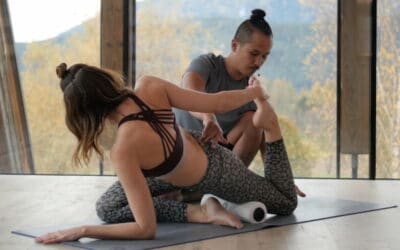One of the most fascinating things about yoga is that the simplest movements and poses can be much more strenuous and complex than expected. One of these poses is Dandasana or Seated Staff Pose.
Even more so, this sitting posture is the starting point for various yoga asanas such as Seated Forward Bend (Pascimottanasana) or Bound Angle Pose (Baddha Konasana), to name just a few.
Think of Dandasana as a seated version of Mountain Pose (Tadasana), which is the starting point for all standing poses. The most important – and probably the hardest – part of this yoga pose is bringing the spine in an upright position that is sustainable.
“This is the pose that makes you feel you suck at yoga.”
Let’s explore in this article what makes this yoga pose so difficult:
1. How Do You Get Into Dandasana (Staff Pose)?

Dandasana is not an easy pose. Photograph: TINT instructors Desirée Rumbaugh and Adrew Rivin.
- Sit down on your yoga mat.
- Extend the legs straight out in front of you and keep the knees slightly bent.
- Flex the toes, i.e. pull them towards the shin to engage the thighs and the muscles surrounding the knee caps.
- Firm the thighs by pressing them down against the yoga mat and rotate them slightly inward, i.e.toward each other.
- Draw the inner groins toward the sacrum.
- Press the heels down into the ground.
- Sit forward on your sitting bones and widen them by taking hold of the flesh of each buttock and moving it out of the way. As a result, you’ll feel much more grounded.
- Elongate the spine and the neck. Image a thin thread is gently pulling you up from the crown of your head. If you notice your torso is leaning back, sit on a blanket or a bolster to lift the pelvis.
- Stack the shoulders directly on top of the hips. Release the shoulders down. To do so, you can roll them up, back and down a few times.
- Place the palms on the ground next to your buttocks for support. Since arm lengths can vary, you can also bend the arms slightly, if needed.
- Broaden across the collarbones and lift the chest.
- Draw your belly button in toward the spine.

Follow these steps to align your body in Dadasana (Staff Pose). Photograph by Freepik.
2. What Is Your Body Doing In Dandasana (Staff Pose)?
2.1. What Are the Joints Doing?
Just like the spine is in neutral or axial extension in Seated Staff Pose, the scapulae should also be in a neutral position. The shoulder is adducted, the elbow extended and the wrist in dorsiflexion.
The hips are flexed and adducted, the knees extended and the ankles in dorsiflexion.
2.2. Which Muscles Are Engaged?
The spinal extensors and flexors contract concentrically and eccentrically to maintain the neutral extension of the spine.
Regarding the upper body, the serratus anterior contracts concentrically to avoid the adduction of the scapulae as a result from the pushing of the arms into the ground. Furthermore, the triceps brachii extend the elbows.
Looking at the lower body, the illiacus contracts concentrically to effect the hip flexion. The pectineus and adductor magnus contract concentrically to effect the adduction and internal rotation of the legs. The articularis genu and vastii are responsible for the extension of the knee.
Understanding the actions the joints and muscles perform in a certain yoga pose, such as Dandasana, is essential to understanding proper alignment in your yoga practice. That’s why we created a free yoga asana ebook for you, which summarizes most important alignment cues for 10 of the most common yoga poses so you can use it as a reference guide in your yoga practice.
3. How Can You Avoid Misalignment in Dandasana (Staff Pose)?
3.1. Neutral Rotation of the Legs
One common misalignment is that the legs rotate outward instead of being straight in line in front of the torso.
In order to keep the legs are neutrally rotated in Seated Staff Pose, most people need muscular effort to consciously rotate the legs internally and prevent them from falling open against the pull of gravity.
3.2. Don’t Let the Lower Back Collapse
Since we’re used to slouching into our chair or on our couch, it has become so difficult for us to sit with a straight back. We simply lost the ability to sit straight. Notice that, if you look at a toddler, they sit with a perfectly straight spine – and they sit with ease!

For toddlers it’s easy to sit with a straight spine. Photograph on unsplash.
However, you don’t want to let the lower back collapse or round in Dandasana, but want to maintain the natural lumbar curve in the spine you get when you elongate the spine from the hips to the top of the head.
Practice Staff Pose with your back against a wall and only your shoulder blades and sacrum touching the wall, not your lower back.
Apart from that, this seemingly easy sitting posture shows how tightness in the legs can lead to spinal flexion (instead of extension), i.e. tight hamstrings can contribute to rounding the back. This is why Seated Staff Pose will become easier as the flexibility of the hamstrings increases.
Meanwhile, you can practice Dandasana with bent knees as this will unlock the knee joint and give you more space in the pelvis.

Keeping the knees bent makes Dandasana easier accessible. Photograph: TINT instructors Desirée Rumbaugh and Andrew Rivin.
3.4. Keep Your Bodyweight Balanced
When you sit in Dandasana, try to distribute your weight equally across both sitting bones. To do this, gently wiggle the hips side to side once you’re in the pose. Once you’re in a neutral position, both the pubic bone and the tail bone should have the same distance from the floor.
3.5. Build the Pose From Toes to Head
Start building Dandasana yoga pose by drawing the base of the big toes forward and aligning the feet, heels, and toes first.
Secondly, bring your awareness into the ankles. Root the heels down into the yoga mat as well as the calves and thighs.
As a next step, focus on the alignment of the tailbone, pelvis, and belly before you bring your awareness to the collarbones, shoulders, arms, and the neck.
Finally, as a last step, elongate and extend yourself by reaching through the crown of your head.
3.6. Incorporate it in Your Daily Life
Dandasana or Seated Staff Pose is a great posture that you can also practice outside your yoga mat. Sitting with a straight spine is a healthy habit to incorporate into your every-day life.
Check and correct your alignment every time you come into this pose – not only during your yoga practice, but also throughout the day and off the mat.
Although Dandasana, or Seated Staff Pose, may be challenging at first, but will become accessible once you’ve understood what to pay attention to when it comes to your alignment. This is why understanding the core principles of correct yoga alignment is the key to mastering all kinds of asanas. To help you with this and other yoga poses, we have created a free yoga asana ebook that you can download for free and use as a reference guide for your yoga practice.
4. How Can You Build Dandasana (Staff Pose) Into Your Yoga Practice?
4.1. Modifications to Accomodate Your Body
Sitting flat on the floor with the legs extended may look like the simplest thing in the world, but when you try it, you’ll notice that it’s not that easy. But don’t worry, many people find this position hard and uncomfortable. This is why props can be a great help.
Practitioners who find it hard to sit up straight and have a rounded back can place a folded blanket, a pillow, bolster or even a block under the buttocks. Elevating the hips really helps to tilt the pelvis forward and lengthen the spine.
It’s also possible to use blocks under the hands if the palms don’t touch the ground.
To check whether the spine is straight, it’s an option to sit with the back against a wall with the shoulder blades touching it and a space between the wall and the lower back. While the sacrum and the shoulder blades should touch the wall, the lower back and the back of the head should not. You can put a small rolled-up towel between the wall and the lower back.
For a Yin yoga version of this pose, keep the feet about hip-width apart and the toes relaxed without letting them fall outside. Practitioners who have difficulties stretching the legs completely can place a bolster underneath the knees. If you want to extend the stretch to the spine, ground the sitting bones, roll the shoulder back, and keep the chest lifted. On an exhalation, start to relax the middle back and lean forward.
In contrast to the more active Yang version of this seated posture, the aim here is to relax the back by rounding it. Drop the head down to release any tension in the neck and rest the backs of the hands next to the legs. Place a block or a bolster between the legs to support the forehead if needed.

Practice a Yin version of Dandasana with Chris Su.
4.2. Challenge Yourself
If you want to take this pose to the next level, you can fold into a Seated Forward Bend (Pascimottanasana).
For a one-legged version of Seated Staff pose to also target the neck and shoulders, bend the right knee and open it out to the side, placing the sole of the foot against the left thigh so that your legs form a 90 degree angle. Keep the chest centered between the legs.
Hold onto both knees with the hands and pull on them to open the chest. Bring the hands together in front of the chest with the thumbs facing the sternum. Lift the chest and reach the arms up.
Feel the upper back muscles engaging and even try to arch the spine. Press the left leg down into the yoga mat. At the same time, lift the chest higher and look toward the thumbs, pressing the palms together. Maintain this pose for some time even though (or especially because) it may feel really intense.

Practice Dandasana (Staff Pose) in Yoga for Neck & Shoulders with Young Ho Kim.
Release the arms and turn your chest so that you can fold over your left leg. With the right hand, take hold of the outer side of the left foot and, if this is available to you, reach the left arm under your right armpit onto your right knee. Release the head down. Stay here for a few breaths before you change sides.

Fold forward in one-legged staff pose.
5. What Are the Benefits of Dandasana (Staff Pose) in Yoga?
Seated Staff Pose provides a great stretch for the hamstrings and calves while at the same time improving spinal awareness. Especially for runners (who tend to have particularly tight hamstrings), this yoga pose can restore some flexibility and help to improve posture.
Furthermore, Dandasana strengthens the back muscles and stretches the shoulders and chest. It can, thus, help to ease back pain when practiced with care.
Probably the best thing about this yoga pose is that you can practice it any time throughout the normal day: Instead of slouching in a chair or on the couch, opt for sitting on the floor with the legs extended in front of you.
With regular and consistent practice, you will gain postural awareness resulting in more grace and balance in all areas of your everyday life. Once getting used to sitting with a straight back, you may even start walking taller and maintaining a better posture in general throughout the day!





